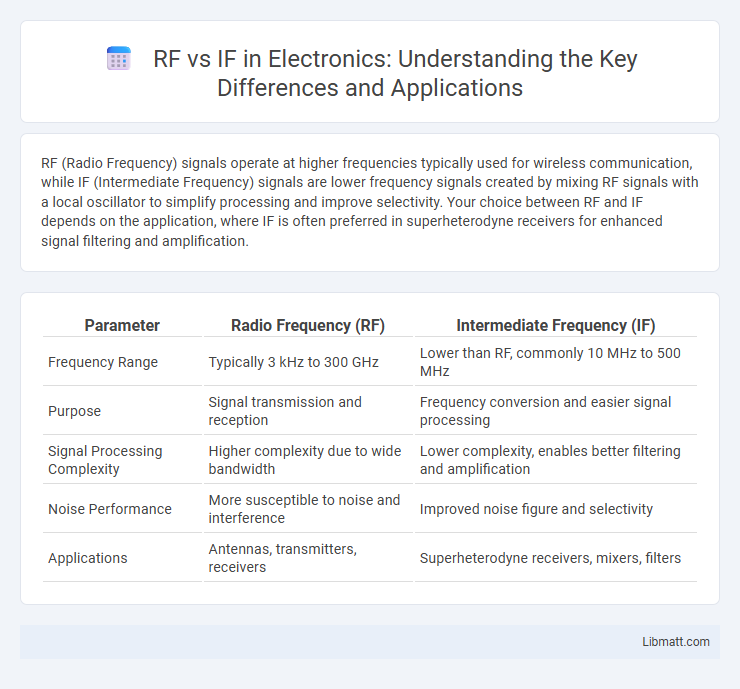RF (Radio Frequency) signals operate at higher frequencies typically used for wireless communication, while IF (Intermediate Frequency) signals are lower frequency signals created by mixing RF signals with a local oscillator to simplify processing and improve selectivity. Your choice between RF and IF depends on the application, where IF is often preferred in superheterodyne receivers for enhanced signal filtering and amplification.
Table of Comparison
| Parameter | Radio Frequency (RF) | Intermediate Frequency (IF) |
|---|---|---|
| Frequency Range | Typically 3 kHz to 300 GHz | Lower than RF, commonly 10 MHz to 500 MHz |
| Purpose | Signal transmission and reception | Frequency conversion and easier signal processing |
| Signal Processing Complexity | Higher complexity due to wide bandwidth | Lower complexity, enables better filtering and amplification |
| Noise Performance | More susceptible to noise and interference | Improved noise figure and selectivity |
| Applications | Antennas, transmitters, receivers | Superheterodyne receivers, mixers, filters |
Understanding RF and IF: Basic Definitions
RF (Radio Frequency) refers to the range of electromagnetic waves used for wireless communication, typically spanning from 3 kHz to 300 GHz, while IF (Intermediate Frequency) is a lower frequency generated by mixing RF signals with a local oscillator to simplify processing. Your devices convert RF signals to IF to improve selectivity and sensitivity during signal demodulation. Understanding these basic definitions helps optimize the design and functionality of radios, televisions, and communication systems.
Key Differences Between RF and IF
RF (Radio Frequency) signals operate at higher frequencies directly transmitted or received by antennas, covering a broad spectrum including VHF, UHF, and microwave bands. IF (Intermediate Frequency) signals are downconverted from RF to a fixed, lower frequency range to simplify processing, filtering, and amplification in communication systems. Understanding the key differences between RF and IF helps optimize your radio receiver design by balancing sensitivity and selectivity through appropriate frequency conversion stages.
Frequency Ranges: RF vs IF
RF (Radio Frequency) typically covers a broad spectrum from 3 kHz to 300 GHz, encompassing frequencies used for wireless communication, broadcasting, and radar. IF (Intermediate Frequency) generally falls within a narrower range, commonly between 30 MHz and 500 MHz, serving as a fixed frequency to simplify signal processing in receivers. Your choice between RF and IF depends on the design goals, with IF providing stable, manageable frequencies for enhanced selectivity and sensitivity.
Typical Applications of RF and IF
RF (Radio Frequency) signals are primarily used in wireless communication systems such as cellular networks, broadcast radio and TV, satellite communication, and radar systems where signals are transmitted and received over the air. IF (Intermediate Frequency) signals are commonly utilized in superheterodyne receivers, including television tuners, radio receivers, and satellite communication equipment, to allow easier and more efficient signal processing and filtering. These applications leverage RF for initial signal capture and transmission, while IF facilitates higher precision in amplification, demodulation, and frequency conversion stages.
Advantages of Using RF
RF (Radio Frequency) signals offer advantages such as lower system complexity and reduced signal degradation by avoiding intermediate frequency conversion. Using RF directly simplifies receiver design and enhances real-time processing capabilities. Your communication system benefits from improved signal integrity and faster response times when operating with RF signals.
Benefits of Intermediate Frequency (IF)
Intermediate Frequency (IF) offers improved signal processing by enabling easier filtering and amplification compared to Radio Frequency (RF) signals, which are often at higher frequencies and more prone to noise. Using IF allows for better selectivity and sensitivity in communication systems, enhancing overall receiver performance. Additionally, IF stages simplify frequency conversion and enable the use of fixed-frequency components, reducing system complexity and cost.
RF and IF in Communication Systems
Radio Frequency (RF) refers to the original high-frequency signal used in wireless communication systems for transmitting data over the air. Intermediate Frequency (IF) is the shifted lower frequency signal obtained after mixing the RF signal with a local oscillator, simplifying filtering and amplification in communication receivers. Using IF enhances signal processing efficiency and selectivity, crucial for accurate data demodulation in communication systems.
Signal Processing: RF vs IF
RF (Radio Frequency) signal processing occurs at the original transmission frequency, requiring high-frequency components and complex circuitry to handle wide bandwidths and mitigate noise. IF (Intermediate Frequency) processing shifts the signal to a lower, fixed frequency, simplifying filtering, amplification, and demodulation while improving selectivity and sensitivity. This frequency conversion enables more efficient and flexible signal manipulation in receivers and communication systems.
RF vs IF: Component Design Considerations
RF component design requires careful attention to signal integrity, impedance matching, and electromagnetic interference due to high-frequency operation, while IF design often benefits from lower frequency signals allowing for simpler filtering and amplification. Designers must consider thermal management and component tolerances more rigorously in RF circuits to maintain performance, whereas IF stages permit greater flexibility in component selection and layout. Your choice between RF and IF impacts system complexity, cost, and overall reliability based on these design considerations.
Future Trends in RF and IF Technologies
Future trends in RF technologies emphasize advancements in millimeter-wave frequencies and 5G/6G networks, enabling higher data rates and improved spectrum efficiency. Integrated IF components are evolving with software-defined radio (SDR) architectures, allowing more flexible and adaptive signal processing in communication systems. Emerging materials like GaN and SiGe enhance device performance, driving innovation in both RF and IF circuits for next-generation wireless applications.
RF vs IF Infographic

 libmatt.com
libmatt.com